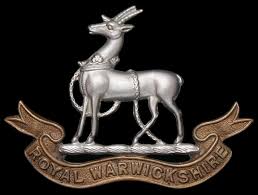Personal Details
Born: 30 October 1889 in Whitchurch, Shropshire and baptised on 27 November 1889 at St. Alkmund`s Parish Church, Whitchurch.
Family: He was one of nine children born to William Tudor, an innkeeper, and his wife Beatrice. No marriage can be found for him.
Residence: Until at least 1901 he was living at The Greyhound Inn, Bargates, Whitchurch. By 1911 he was a boarder at 19 Chester Street, Chester, Cheshire. An address of the Greyhound Inn, Bargates, Whitchurch was given for him on the 1919 Absent Voters` List . In 1939 there is a possible address of 2 Beche Road, Colchester, Essex.
Employment: In 1911 he was working as a shop assistant in household furnishings. By 1939 his occupation was that of furniture store manager.
Died: 1976, Colchester, Essex, aged 86.
Military Details
Regiment: Royal Warwickshire Regiment
Rank: Sergeant
Service Number: 307082
Date of Enlistment: Not known
Date of Discharge: 11 April 1919
Reason for Discharge: Not known
Ernest was awarded the Campaign Medals (British War Medal and Victory Medal)

The British War Medal (also known as 'Squeak') was a silver or bronze medal awarded to officers and men of the British and Imperial Forces who either entered a theatre of war or entered service overseas between 5th August 1914 and 11th November 1918 inclusive. This was later extended to services in Russia, Siberia and some other areas in 1919 and 1920. Approximately 6.5 million British War Medals were issued. Approximately 6.4 million of these were the silver versions of this medal. Around 110,000 of a bronze version were issued mainly to Chinese, Maltese and Indian Labour Corps. The front (obv or obverse) of the medal depicts the head of George V. The recipient's service number, rank, name and unit was impressed on the rim.
The Allied Victory Medal (also known as 'Wilfred') was issued by each of the allies. It was decided that each of the allies should each issue their own bronze victory medal with a similar design, similar equivalent wording and identical ribbon. The British medal was designed by W. McMillan. The front depicts a winged classical figure representing victory. Approximately 5.7 million victory medals were issued. Interestingly, eligibility for this medal was more restrictive and not everyone who received the British War Medal ('Squeak') also received the Victory Medal ('Wilfred'). However, in general, all recipients of 'Wilfred' also received 'Squeak' and all recipients of The 1914 Star or The 1914/1915 Star (also known as 'Pip') also received both 'Squeak' and 'Wilfred'. The recipient's service number, rank, name and unit was impressed on the rim.

